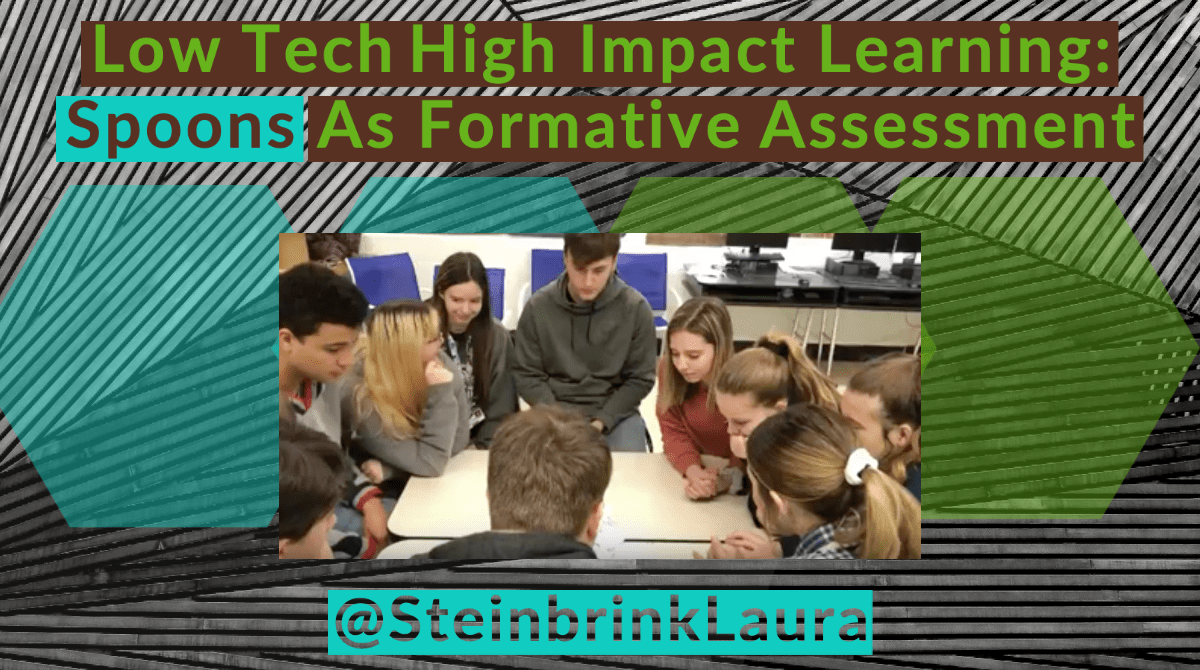Her moonlit wings reflect the stars that guide me towards salvation
In the age of technology, teaching can be very challenging. Teachers are called upon to not only engage students in the learning process, but also make sure we see to it that Maslow’s Hierarchy of Needs, Bloom’s Taxonomy and Webb’s Depth of Knowledge are followed or met. We have to make sure students can assess their own learning, self-regulate, collaborate, create, and think critically. While doing all of that, we also need to assure student mastery of the state standards. I’m exhausted just thinking about it.
I stopped an old man along the way
So while I am always on the lookout for ways to bring the latest technology into my classroom, my goal is not to just bring tech to my students. My pedagogy guides my use of tech, and recently, my use of spoons. Helping students practice mastery in an engaging way is always my goal. One morning in my first hour Spanish class, I contemplated student interests and how I might leverage that for our Friday Fun day. I love to make Fridays a really fun but still covering content kind of day for students to cap off their week. We generally take vocabulary or content quizzes at the beginning of the hour and then engage in a fun learning experience. So as students poured into my room after the first bell stopped ringing, I thought about how much fun students have playing the card game Spoons. Out loud, I said, “There’s got to be a way to make a Spanish learning version of Spoons.” One of my top students immediately responded with a brilliant idea, so while they took their weekly quiz, I grabbed spoons, masking tape, and a Sharpie.
Content Spoons (Formative Assessment):
Hoping to find some old forgotten words or ancient melodies
Gather enough spoons to cover the content with more than one correct answer. If only one spoon has the right answer, the game can get a tad violent rather quickly, especially with high school students. I used masking tape and a Sharpie to write the responses and then taped them to the spoons. For larger classes, place students in smaller groups and make sure each group has the same number of spoons with answers/responses.
He turned to me as if to say
Ensure that the spoons are face down so that the written content on the tape is not visible. You, the teacher, say the question, subject, vocab term, math problem, etc., and the students grab spoons to frantically find the answer. I give a point to students with the right answer/spoon, and we play until the bell rings. The magic is, nobody looks at their phones or tries to put up early. Students can’t wait for the next round, and neither can I. The period flies by and students are smiling, laughing, and talking about the experience as they leave the room. Students from the next period are begging to get to play it too. I might need to invest in the plastic spoons market. I can easily tell which students understand the concept or know the correct answer by their reactions to the spoons they end up with, or by their expressions as they hold the spoon up for me to see. I do try to enforce the “grab only one spoon” rule, but it’s hard to do sometimes while giggling at the effort…er lengths my students will go to for the right spoon.
“Hurry boy, it’s waiting there for you”
This is very adaptable and flexible, so make it fit what works with your students, but keep in mind that what works really well for students in a rural Missouri school district may not work as well where you live and teach. Those students in front of you are the secret to the success of any learning experience that you try. Get to know them. Keep in mind what they are passionate about, what they find fun, what is currently popular, and then see what you can do to blend it in with your content. Look around. There’s fun ways to learn everywhere, but if you still aren’t sure, ask your students. I love seeing what they come up with for our Fun Fridays. My best learning experiences for Fun Fridays have been student ideas that have involved writing, augmented reality, game shows, and now spoons. What else can we bring in that can set off a spark that may later ignite into a roaring passion for learning? Challenge yourself and your students to find fun ways to learn, one day each week. You may be surprised at the results. I always am.

